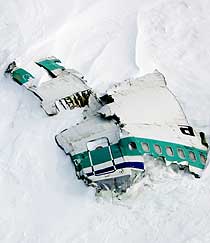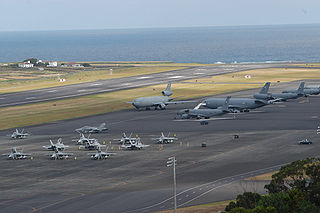
The Antonov An-225 Mriya was a strategic airlift cargo aircraft designed in the 1980s by the Antonov Design Bureau in the Soviet Union. It was originally developed as an enlargement of the Antonov An-124 to transport Buran-class orbiters, and only one example was ever completed. After successfully fulfilling its military missions, the aircraft was mothballed for eight years. It was then refurbished and reintroduced into commercial operation with Antonov Airlines, carrying oversized payloads. While a second airframe with a slightly different configuration was partially built, construction was halted more than once due to a lack of funding and interest. This second aircraft was last brought up to 60–70% completion in 2009.

The Douglas C-54 Skymaster is a four-engined transport aircraft used by the United States Army Air Forces in World War II and the Korean War. Like the Douglas C-47 Skytrain derived from the DC-3, the C-54 Skymaster was derived from a civilian airliner, the Douglas DC-4. Besides transport of cargo, the C-54 also carried presidents, prime ministers, and military staff. Dozens of variants of the C-54 were employed in a wide variety of non-combat roles such as air-sea rescue, scientific and military research, and missile tracking and recovery. During the Berlin Airlift it hauled coal and food supplies to West Berlin. After the Korean War it continued to be used for military and civilian uses by more than 30 countries. It was one of the first aircraft to carry the President of the United States, the first being President Franklin D. Roosevelt during World War II.

The Antonov An-72 is a Soviet/Ukrainian transport aircraft, developed by Antonov. It was designed as an STOL transport and intended as a replacement for the Antonov An-26, but variants have found success as commercial freighters.
This is a list of aviation-related events from 1967:
This is a list of aviation-related events from 1978:

The Antonov An-2 is a Soviet mass-produced single-engine biplane utility/agricultural aircraft designed and manufactured by the Antonov Design Bureau beginning in 1947. Its durability, high lifting power, and ability to take off and land from poor runways have given it a long service life. The An-2 was produced up to 2001 and remains in service with military and civilian operators around the world.

The Antonov An-26 is a twin-engined turboprop civilian and military transport aircraft, designed and produced in the Soviet Union from 1969 to 1986.

The Antonov An-28 is a twin-engined light turboprop transport aircraft, developed from the Antonov An-14M. It was the winner of a competition against the Beriev Be-30, for use by Aeroflot as a short-range airliner. It first flew in 1969. A total of 191 were built and 16 remain in airline service as at August 2015. After a short pre-production series built by Antonov, it was licence-built in Poland by PZL-Mielec. In 1993, PZL-Mielec developed its own improved variant, the PZL M28 Skytruck.

The Antonov An-30, is a development of the An-24 designed for aerial cartography.

McMurdo Sound is a sound in Antarctica. It is the southernmost navigable body of water in the world, and is about 1,300 kilometres (810 mi) from the South Pole.

The Mount Erebus disaster occurred on 28 November 1979 when Air New Zealand Flight 901 (TE-901) flew into Mount Erebus on Ross Island, Antarctica, killing all 237 passengers and 20 crew on board. Air New Zealand had been operating scheduled Antarctic sightseeing flights since 1977. This flight was supposed to leave Auckland Airport in the morning and spend a few hours flying over the Antarctic continent, before returning to Auckland in the evening via Christchurch.

Lajes Field or Lajes Air Base, officially designated Air Base No. 4, is a multi-use airfield near Lajes and 15 km (9.3 mi) northeast of Angra do Heroísmo on Terceira Island in the Azores, Portugal. It is home to the Portuguese Air Force Base Aérea N º4 and Azores Air Zone Command, a United States Air Force detachment unit, and a regional air passenger terminal. Located about 3,680 km (2,290 mi) east of New York City and about 1,600 km (990 mi) west of Lisbon, Portugal; the base sits in a strategic location midway between North America and Europe in the north Atlantic Ocean.

Air Transat Flight 236 was a transatlantic flight bound for Lisbon, Portugal, from Toronto, Canada, that lost all engine power while flying over the Atlantic Ocean on August 24, 2001. The Airbus A330 ran out of fuel due to a fuel leak caused by improper maintenance. Captain Robert Piché, 48, an experienced glider pilot, and First Officer Dirk de Jager, 28, glided the plane to a successful emergency landing in the Azores, saving all 306 people on board. Most of the passengers on the flight were Canadians visiting Europe or Portuguese expatriates returning to visit family in Portugal. This was also the longest passenger aircraft glide without engines, gliding for nearly 75 miles or 121 kilometres. Following this unusual aviation accident, this aircraft was nicknamed the "Azores Glider".

Korean Air Lines Flight 902 was a scheduled Korean Air Lines flight from Paris to Seoul via Anchorage. On 20 April 1978, the Soviet air defense shot down the aircraft serving the flight, a Boeing 707, near Murmansk, Soviet Union, after the aircraft violated Soviet airspace.

The Last Ship is a 1988 post-apocalyptic fiction novel written by William Brinkley. The Last Ship tells the story of a United States Navy guided missile destroyer, the fictional USS Nathan James (DDG-80), on patrol in the Barents Sea during a brief, full-scale nuclear war between the United States and the Soviet Union. It details the ship's ensuing search for a new home for her crew.

Sepahan Airlines Flight 5915 was a scheduled domestic passenger flight from Iranian capital Tehran Mehrabad International Airport to Tabas, South Khorasan Province, Iran. On 10 August 2014, the HESA IrAn-140 twin turboprop serving the flight crashed shortly after takeoff from Mehrabad International Airport, falling into a boulevard near the Azadi Stadium. Of the 42 passengers and six crew on board, 40 people died.

Aeroflot Flight A-13 was a scheduled Soviet domestic passenger flight from Baku, Azerbaijan to Fort-Shevchenko in Kazakhstan that crashed on 18 August 1973 shortly after takeoff killing 56 of the 64 passengers and crew aboard. The Antonov An-24 had suffered an engine failure on takeoff and was attempting to return to the airport when it struck an oil rig cable at low altitude resulting in a crash. At the time, it was the second worst accident involving the An-24 and remains the worst aviation accident in Azerbaijani history. The engine failure had been caused by the effect of continuous overheating on the performance of the blades.















